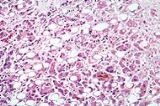
Hepatitis
Overview
Hepatitis is a medical condition defined by the inflammation of the liver
and characterized by the presence of inflammatory
cell
s in the tissue
of the organ. The name is from the Greek hepar (ἧπαρ), the root being hepat- (ἡπατ-), meaning liver, and suffix -itis, meaning "inflammation" (c. 1727). The condition can be self-limiting (healing on its own) or can progress to fibrosis
(scarring) and cirrhosis
.
Hepatitis may occur with limited or no symptoms, but often leads to jaundice
, anorexia
(poor appetite) and malaise
.
Liver
The liver is a vital organ present in vertebrates and some other animals. It has a wide range of functions, including detoxification, protein synthesis, and production of biochemicals necessary for digestion...
and characterized by the presence of inflammatory
Inflammation
Inflammation is part of the complex biological response of vascular tissues to harmful stimuli, such as pathogens, damaged cells, or irritants. Inflammation is a protective attempt by the organism to remove the injurious stimuli and to initiate the healing process...
cell
Cell (biology)
The cell is the basic structural and functional unit of all known living organisms. It is the smallest unit of life that is classified as a living thing, and is often called the building block of life. The Alberts text discusses how the "cellular building blocks" move to shape developing embryos....
s in the tissue
Tissue (biology)
Tissue is a cellular organizational level intermediate between cells and a complete organism. A tissue is an ensemble of cells, not necessarily identical, but from the same origin, that together carry out a specific function. These are called tissues because of their identical functioning...
of the organ. The name is from the Greek hepar (ἧπαρ), the root being hepat- (ἡπατ-), meaning liver, and suffix -itis, meaning "inflammation" (c. 1727). The condition can be self-limiting (healing on its own) or can progress to fibrosis
Fibrosis
Fibrosis is the formation of excess fibrous connective tissue in an organ or tissue in a reparative or reactive process. This is as opposed to formation of fibrous tissue as a normal constituent of an organ or tissue...
(scarring) and cirrhosis
Cirrhosis
Cirrhosis is a consequence of chronic liver disease characterized by replacement of liver tissue by fibrosis, scar tissue and regenerative nodules , leading to loss of liver function...
.
Hepatitis may occur with limited or no symptoms, but often leads to jaundice
Jaundice
Jaundice is a yellowish pigmentation of the skin, the conjunctival membranes over the sclerae , and other mucous membranes caused by hyperbilirubinemia . This hyperbilirubinemia subsequently causes increased levels of bilirubin in the extracellular fluid...
, anorexia
Anorexia (symptom)
Anorexia is the decreased sensation of appetite...
(poor appetite) and malaise
Malaise
Malaise is a feeling of general discomfort or uneasiness, of being "out of sorts", often the first indication of an infection or other disease. Malaise is often defined in medicinal research as a "general feeling of being unwell"...
.
Unanswered Questions

